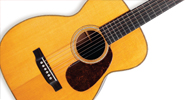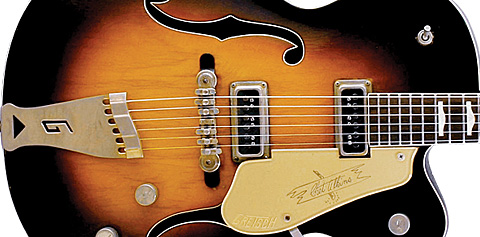
Photo: Jeff Hahne.
Jonathan Wilson is having a very good year.
His Gentle Spirit CD (Bella Union), a hippie-soul drenched 80 minutes of folk-psych-rock goodness, has earned international praise. He toured Europe throughout 2012 to widespread acclaim, including a stint opening for Tom Petty and the Heartbreakers, turned numerous heads with his performance at the Jerry Garcia 70th birthday celebration gig, and his supporters and collaborators include some of the most respected names in the business, including Chris Robinson of the Black Crowes, Jackson Browne, and Elvis Costello.
But this isn’t an overnight success story. It’s the latest stop on a 25-year musical journey that has taken the 37-year-old North Carolina native from Charlotte to New York to Los Angeles, where he’s played a leading role in the recent “Laurel Canyon Sound” revival.
Wilson, who’s also made a name for himself as a producer (Dawes, Father John Misty, Roy Harper), has a passion for vintage gear and sports an impressive collection. He recently gave VG the low-down.
What were your main guitars and amps on Gentle Spirit?
The main electrics are a ’73 Gibson ES-355, a ’76 Les Paul Deluxe goldtop, a GVCG (Greenwich Village Custom Guitars, built by Wilson) ’57 with Lollar Pickups, a GVCG ’63 S model with superb Alan Hamel pickups, a ’57 Les Paul Junior, a ’67 Höfner violin bass, a GVCG ’63 J-bass with Duncan Antiquity pickups, and a Guyatone hollowbody Gibson-EB-style bass. It has a Duncan Rickenbacker-style pickup that’s just amazing.
The main acoustics on the record are my ’46 Martin 000-18 and two Gibson J-50s – a ’47 and a ’62. I use an Orange-label Yamaha FG strung Nashville-style, and a few different Guild 12-strings. The main nylon-string acoustic is a ’57 Martin 00-18G.
There are a few other secret weapons/odds and ends – a Jerry Jones Coral Sitar replica, an Old Kraftsman Kay two-pickup hollowbody that has a screaming bridge pickup, a ’62 Gretsch Chet Atkins that was my first great vintage guitar, and a Gibson Skylark lap steel.
The main amps are a ’63 Vox AC30 – Bass model, non-top-boost, and my mainstay amp since I was 13 year old – a ’66 Blackface Princeton Reverb. Other amps used were a ’67 Marshall plexi Tremolo 50, a ’60 Champ, and a ’66 blackface Super Reverb. There is also a fair amount of direct-to-the-console recording of guitar and bass.
Almost all the bass was recorded direct through my old Telefunken V-72s. I also use a tweed Champ for bass – small speakers equal big sounds for me in the studio. The main guitar on Valley Of the Silver Moon, for instance, is the GVCG T model through the ’63 Vox AC30 with only one pedal – an old MXR script-logo Phase 45. That tune was tracked live, so the solos were kept as they were played. The electric guitar in “The Way I Feel” was the Gibson ES-355, which has an amazing microphonic bridge pickup, it was just dimed through the Princeton; no effects, just a two-microphone setup, one close, one distant. Most of the acoustics on the record were double-tracked. On some tunes, the parts were doubled an octave up on the Nashville strung acoustic, which makes for a trippy 12-string effect. “Rolling Universe” is an example.

Half the album was done with a group of musicians, and the other half was done on your own. How did that break down, and did the band bring its own gear?
Roughly half of the record I did alone, and the rest is with a core band that tracked live for a week or so. Most of the gear was at my studio, so the guys didn’t have to bring much. The Vox Continental and ’64 Hammond A-100 comprise most of the organ sounds. There’s an old Mellotron m400 that shows up a lot. Josh Grange (Dwight Yoakam, k.d. Lang) who played pedal steel on the record, brought his Sho-Bud and his own effects.
In the video for “Desert Raven” you play a unique guitar. What is it, and did you use it on the actual recording? It sounds like there’s also an acoustic 12-string on that track…
Ha! That’s a funky ’50s Kay I found at a shop, someone had played the thing to death; the hardware had turned to black rust from sweat, and it has square sound holes cut into the body, I guess to “acoustify” it. It’s amazing the electronics still work. The recording is three guitars – a Guild acoustic 12-string, a Fender electric for single-coil sound on one side, and Gibson for humbucker tone on the other side, with a bit of MXR Phase 45. It’s the blackface Princeton Reverb again, as well. I’ve used that amp on hundreds of tracks.
On “The Way I Feel,” is that a Höfner bass? It has a great McCartney-esque tone.
That’s the Guyatone hollowbody. It’s a bit more compressed-sounding than the Höfner. The Höfner has a tremendous amount of low-end, sometimes too much, really. Höfners are tricky basses to record, I find. The Guyatone does that flat-wound/picked hollowbody tone better than any other bass I’ve heard. I scored it back in the day somewhere in North Carolina. It had suffered a headstock break, and Pat Walters, the guitar guru in Charlotte, fixed it and installed a killer Rickenbacker-style pickup. I played bass on that tune, and we tracked it live with Adam MacDougall on Hammond and Otto Hauser on drums. We improvised the jam sections, then I went back later and added electric guitar using the 355. I owe my dad a thank you for that guitar, it’s his, actually, but it’s on sort of perma-loan to me. It’s a great one.
What about pedals? You’ve been collecting them for a long time.
Pedals, I do love! I built some cool Rangemaster clones under the GVCG name, using only vintage parts, transistors, caps, cases, switches – even the screws were old flathead screws! I made a few fuzzes, as well, but most of my pedals are boutique studio pieces, not as groovy for live use.
When I play live, I use a slew of Catalinbread pedals, they are my favorite company out there and they’re making the coolest, most creative and best-sounding pedals. I had one of their earliest – an amazing clean boost called the Chile Picoso. I still use it. I also have their RAH, Octave Fuzz, and a MANX, which is a killer early Big Muff-style fuzz.
Do you hit the shops when you’re on the road?
I do, on occasion find great stuff out here on the road.
Any particularly cool scores lately?
I just picked up a one-of-a-kind ’60s Höfner Colorama that has been outfitted with so much aluminum and etched silver it looks like a Zemaitis. It’s very cool. I like to scour Germany and Switzerland for microphones; I just found a mint-condition matched set of Beyer M260 Ribbon mics for $100! That was a rare score. Italy is great for finding bizarre guitars and organs. Europe, in general, is a lot of fun to scour for odd pieces we don’t have back home. I google music stores in most towns we show up in.

You’ve had to move your Five Star Studios, correct?
It was in my house in Laurel Canyon, but I’ve since moved to Echo Park. It was a unique arrangement – a crazy little wooden bungalow on a huge piece of land where an estate had once stood. The property was amazing and the house was meager. Every inch of the place was filled with gear. It was a two-room affair that I turned into an improvised live room/control room setup, with isolation booths being the bathroom, kitchen, anywhere we could get separation. We actually put the guitar amps and Leslie cabinet outside and covered with blankets to record. There was also a plate reverb outside in a chain-link dog pen. We covered that in tarps and named it the Dog Pen Reverb. The studio was built around a 1972 MCI JH-416 console that has been heavily modified, and an Otari MX-80 2″ 24-track. Mixes were done to an Ampex ATR-102 1/4″ two-track.
The good ol’ “dog pen reverb” That’s Carolina style right there man! You might want to talk to Mike Matthews about putting that into production! So, does your Echo Park spot have a dog pen for reverb, as well?
Ha! There is actually a perfect concrete basement room in the new spot. It’s happier now than in Laurel Canyon. Upstairs in the control room, I have a collection of spring reverbs, plus an AKG, an old Pioneer unit, and a classic Fender Reverb tank. Every reverb is physical. I have not used digital reverb in years, though I do like it sometimes in conjunction with real units.
What about outboard gear?
I have a decent amount of vintage outboard, Urei 1178, DBX 160VUs, RCA BA6A, Blackface 1176s, Telefunken V-72s, a bunch of API 512s, a pair of Neve 1073s, a Quad Eight sidecar, various other goodies, but a very typical simple ’70s and ’80s 24-track analog setup. I also have a digital rig – Pro Tools, Logic, etc. that gets used for certain tunes. The new space is much bigger and more elaborate, and the gear has doubled, if not tripled! I now have Jackson Browne’s Studer A-80 24-track, several more pianos and Mellotrons, organs, and a slew of microphones I’ve collected since the record was released – a ’50s Neumann U-47, U-67, U-87, etc.

2) This ’62 Gretsch Chet Atkins Tennessean was the first vintage guitar Wilson bought – he was 13 at the time. “It’s stock, untouched, and I still use it,” he said.
3) “I ordered this after seeing George Harrison with one on the cover of Cloud Nine,” Wilson said of his Gretsch Duo Jet. “Early-’90s Gretsch reissues are wonderful; the DeArmond pickups are outstanding – some of the best clean tones I’ve ever heard.”

5) Wilson calls this ’60s Höfner Colorama, “One of my secret weapons in the studio. Its pickups scream like P-90s on steroids, plus it’s got crazy coil tapping/phase switching mods that enable it to sound like that Marc Bolan half-cocked wah filter tone.”
6) “This is another guitar I kidnapped from my dad,” Wilson said of this ’79 Rickenbacker 340/12. “He’s a Beatles nut, so Ricks were always on the brain. It took me a while to realize just how amazing they are. After touring with Tom Petty and the Heartbreakers, I have an even greater appreciation.”

8) This ’62 Gibson J-50 is Wilson’s favorite acoustic in the studio. “I’ve used it on every record I’ve made. It’s a perfect rhythm acoustic.”
9) This ’46 Martin 000-18 is the guitar Wilson uses to record when he need definition in a fingerpicked part. “It performs flawlessly after a rough life,” he said. “It weighs about three ounces – it’s a feather!”
So how did you score Jackson Browne’s tape machine?
Jackson was kind enough to drop Elsie, his gorgeous Studer A-80 2- track 2″ machine, on me. He used it to record many of his hits in the later ’70s all the way through the ’90s. It was also used to record many artists in his studio, Warren Zevon among them. This is the machine they used to take on tour to record remotely. It has been modified by the great Ed Wong to be portable enough to fit in a road case and loaded into a truck. Ed is Jackson’s studio tech guru, and the fact Ed and his team have maintained this machine since it was new is invaluable. It functions beautifully and sounds amazing. I have a picture Jackson gave me of him hugging the machine in the early ’80s, and he’s in a stylish bomber jacket to boot!
Will you be recording him on it in the future?
I’ve worked on several things with Jackson recently, one was a Dylan tune with myself, Benmont Tench, and Jim Keltner. I hope we do more. He’s one of my best buddies and has done so much for me, I can’t thank him enough.
When you work with other artists – and you’ve racked up an impressive list of collaborations – do you use your gear?
My guitars and amps are almost exclusively used on records I produce. Not just because it’s convenient and accessible, but because I’m so familiar with the tonal behavior of every piece – guitars, amps, drums, cymbals, keyboards, etc. I’m not a tyrant, so if a musician has gear he or she is comfortable playing and needs to have it, by all means, we use it. For example, recently when recording Glen Campbell, his tech brought in some sort of reissue/blackface-inspired amp I didn’t like at all, I think they’re overly bright and sound nothing like the amps they look like. I pushed for Glen to use my ’66 Princeton Reverb with the Sandhill Ribbon, and I’m glad we did – the solo we captured on “Witchita Lineman” is stunning. Glen’s playing is amazing. He did use his own guitar, a funky little Frankenstein Duo-Sonic or Musicmaster.
With in-house gear, though, nine out of 10 times I find musicians are really excited to use the pieces I’ve collected, It’s good stuff, and well-maintained. Between myself and my head engineer, Bryce Gonzales, there isn’t much we can’t fix in a studio. Bryce makes killer tube amps and compressors, and we’ve built a fair amount of the outboard gear at Five Star Studios.
That segues into the microphones, preamps and compressors as well, each one of course has a character and identity. Part of the reason an artist/musician/producer with a studio has all of this kit is to complete a palette of sounds or at least attempt to. There will always be something you need or want that some other wizard or rich gear geek has. I spent far too long in that rabbit hole in years past. Now I know that a solid signal chain that will work well is the most important thing. Actually recording music needs to be the priority, not the gear quest. There are certain standards that I adhere to, and that’s a discreet or tube preamp, a great microphone, and a good recording medium with bandwidth in the sonics department. I’ve spent several decades with most of this gear and I know the color of each piece by now and how it will sit in a track.
You opened for Tom Petty and the Heartbreakers in Europe this summer. What was your live rig for that tour?
The tour with Tom and company was an absolute pleasure. It’s been a true high point to hang with and listen to the Heartbreakers every night. They are responsible for some of the best guitar tones you will ever hear on a stage. Mike Campbell is one of my heroes and one of the sweetest, most soulful guys on the planet.
For the whole European tour, my electric rig was two early-’60s Bassman heads with 2×12 cabs. One is a ’63, the other a ’62. Both are 6AB6 circuits, which is my absolute favorite Fender sound. It’s a bit of a marriage between tweed and the hi-fi blackface tone. I split the signal with a Fulltone TTE, and we mic both cabs, one with a Sandhill active ribbon mic, which is this unreal new microphone from Finland. The other cab gets a Sennheiser 409.
My acoustic rig was something I really loved plugging in every night, which is a very rare happening, as usually acoustic-guitar pickups make one cringe. The guitars I’m using are the new Gibson Jackson Browne models, which are based on ’30s 12-fret models like the Roy Smeck Stage Deluxe. Jackson has been working on and tweaking the perfect amplified acoustic guitar tone for many years and this is the culmination of all of his efforts, and in conjunction with Gibson’s Custom Shop, they have created truly the ultimate live acoustic guitar sound. The pickup system that’s the key to the whole thing is the Trance Audio Acoustic Lens/Amulet system, and Gibson has worked closely with Jackson and master luthier Bill Asher to perfect the installation of the Trance system. The result is a two-channel natural and beautiful image of the guitar, which is actually inspiring for the player, even in the monitors! I never thought that was possible. In large rooms, it really shines. A few weeks ago, we played Royal Albert Hall, and the acoustic filled the room. I was grinning ear to ear, it’s really that good.

Which electric guitars do you use live?
Both are guitars I made six or seven years ago. I made them out of necessity, really; I needed guitars that felt and sounded a certain way, and outside of playing a real ’62 Strat and a ’57 Telecaster, this was the only way to do it. I made quite a few for friends and fellow players through the years. I went through a period where working with my hands held my interest and was much more fulfilling than the music business. I had a knack for making instruments sound and feel authentic, and that resonated with the players who got their hands on one.
Live, you do some great pedal sounds reminiscent of Garcia in the late ’70s. What was that?
That is very Garcia-esque because it’s the same brand he used! It’s a Mutron Micro 5, a simple pedalboard version of the Mutron 2, which is what Jerry used, I believe.
Will your early CD, Frankie Ray, be re-released anytime?
Frankie Ray will be released when the time is right, which is to say when it will not interfere with my current releases, etc. There has been a lot of interest in it, partly because it’s been this mysterious, difficult-to-find record. CDs have fetched over $200 online. Come to think of it, maybe we should put it out next week!
Seriously though, Frankie Ray has a lot of good tunes. We play several of them live, and I always enjoy playing material from that record. It’s unique among my stuff, as it was written and recorded in New York City, so it’s got a different energy than my California-centric or early North Carolinian stuff.
How about other earlier recordings?
There are others, earlier stuff, but I’ll save that for down the line, when I’m archiving in the cabin in the Alps.
What are plans for new recordings? You’ve been extremely busy lately, but have you been able to start on a follow-up to Gentle Spirit?
Yes, I’ve recorded several tunes for it during touring breaks. Also, the band has been playing four or five tunes that will appear on the new record. So we’ll go in and track a good bit of it live. The rest, I will do alone, like I always have. I like to organize a record by myself, sit and marinate on the scope of the thing for a while. I like to work in solitude, I’ve always done it that way, so this won’t be any different. Things have picked up such an incredible momentum with Gentle Spirit, it far surpassed anyone’s expectations, really. We circled the world several times on this record and played so many amazing shows and countries, and I’m excited to get the next one out and do it all over again.
This article originally appeared in VG January 2013 issue. All copyrights are by the author and Vintage Guitar magazine. Unauthorized replication or use is strictly prohibited.

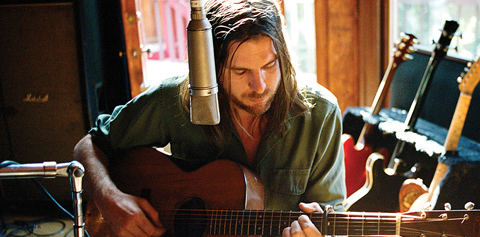

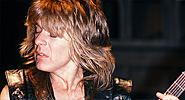


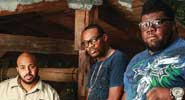




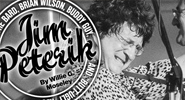



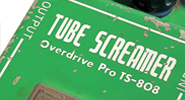



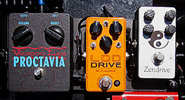
 Verheyen’s primary pedalboard for stage use has traveled the world with him. “I plug the guitar into a Crybaby wah and from there it goes to the red Lehle switcher with the Carl Verheyen mod,” he said. “This means I can hit just one button to switch between rigs, and I never have to look down to find the A or B channel while singing. For the clean-rhythm side, I go out through the Zen Drive pedal to the Clean output of the silver routing box at the top right. My delays and reverbs are rack mounted for both sides of the A/B rig.
Verheyen’s primary pedalboard for stage use has traveled the world with him. “I plug the guitar into a Crybaby wah and from there it goes to the red Lehle switcher with the Carl Verheyen mod,” he said. “This means I can hit just one button to switch between rigs, and I never have to look down to find the A or B channel while singing. For the clean-rhythm side, I go out through the Zen Drive pedal to the Clean output of the silver routing box at the top right. My delays and reverbs are rack mounted for both sides of the A/B rig.
